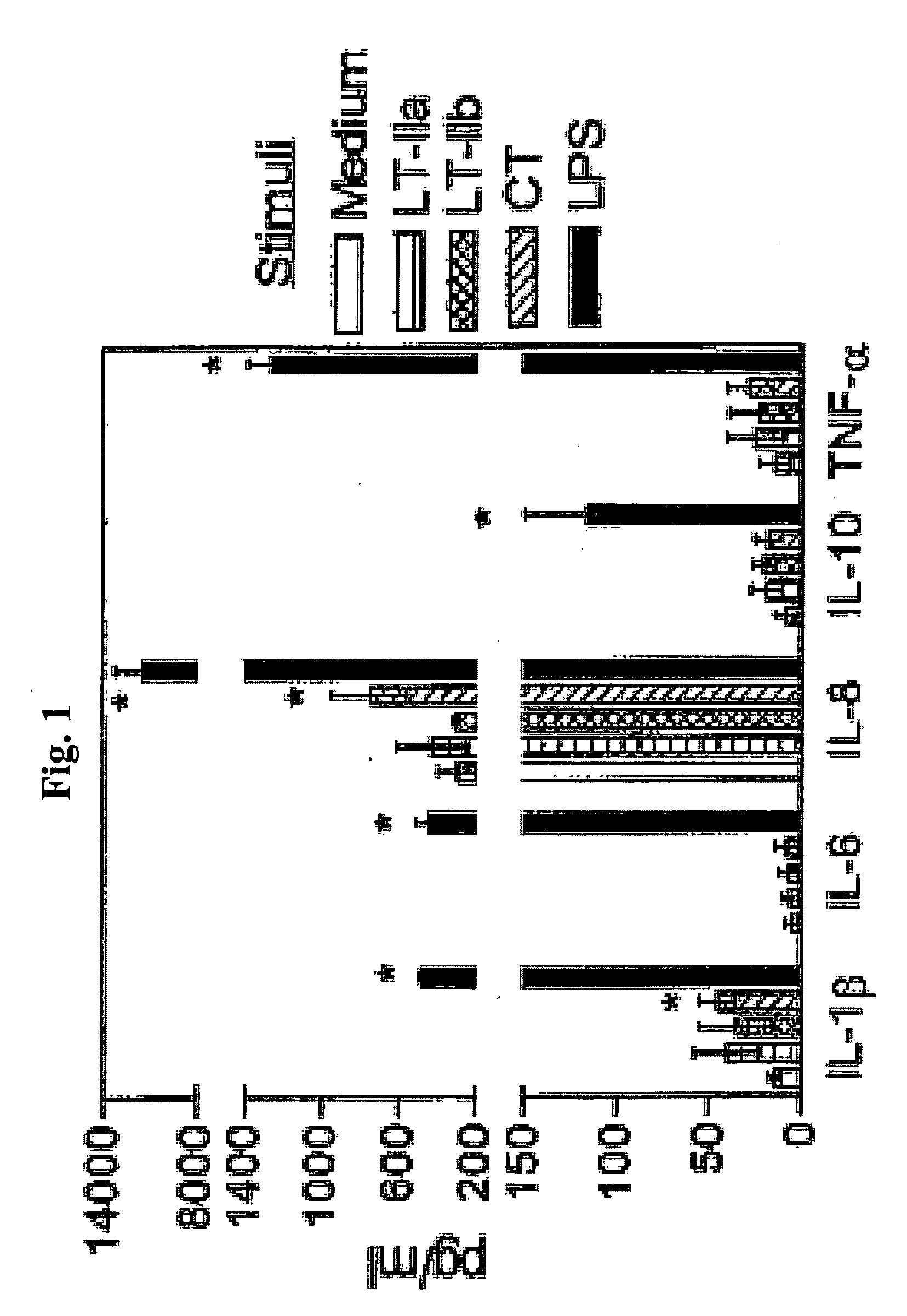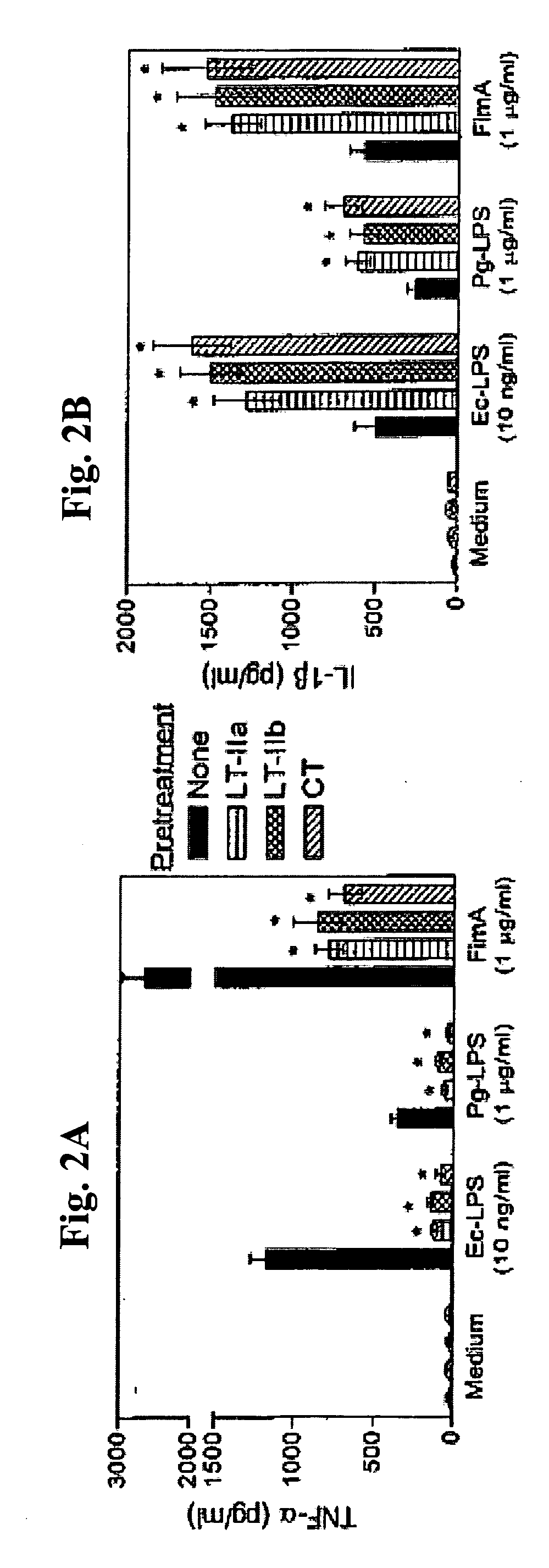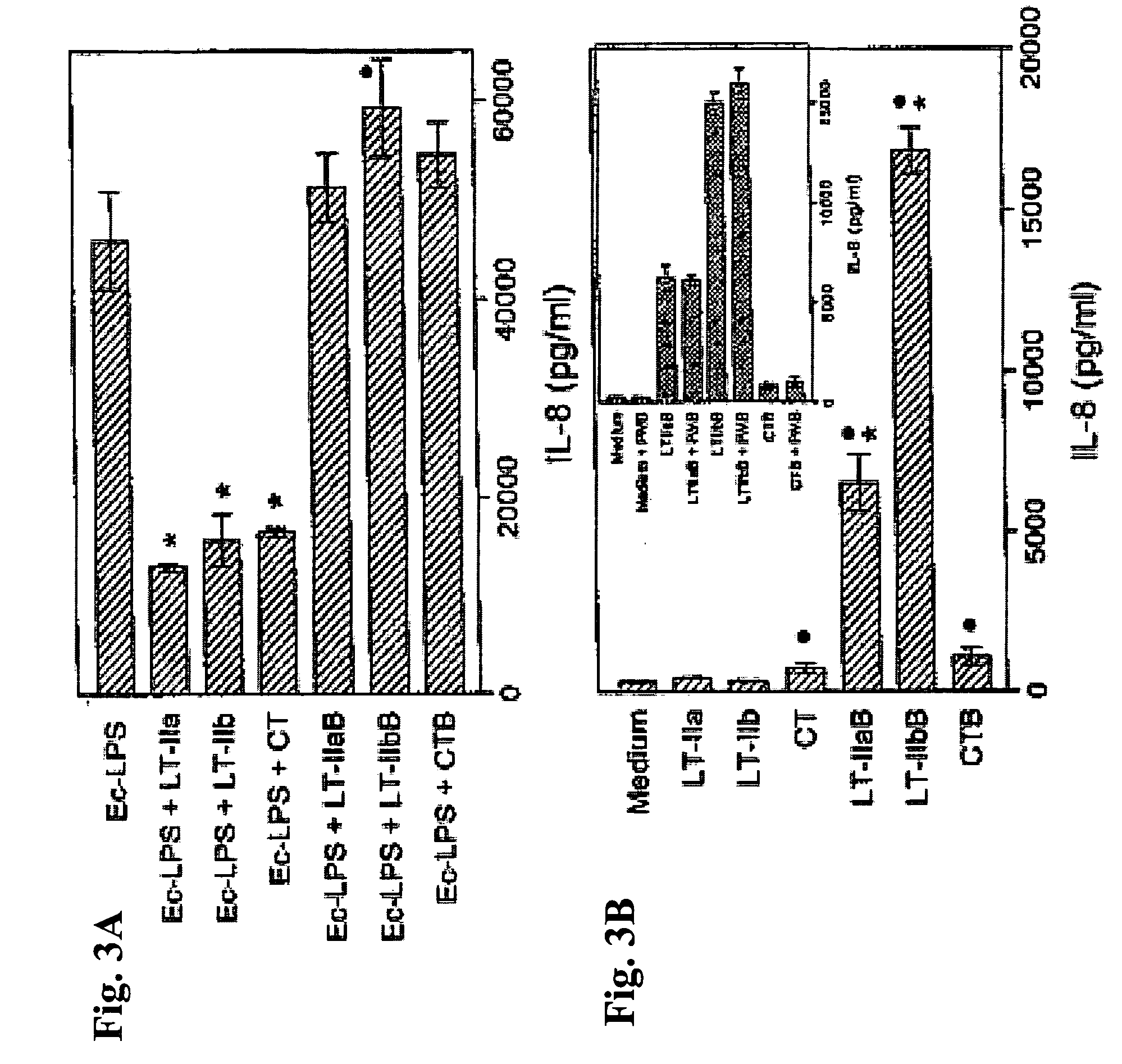Adjuvant activities of B pentamers of LT-IIa and LT-IIb enterotoxin
a technology of enterotoxin and pentamer, which is applied in the field of adjuvants, can solve the problems of reducing the capacity of enterotoxin to participate in retrograde trafficking, ineffective in inducing proinflammatory cytokine release, etc., and achieves the effects of enhancing the immunological response to an antigen, increasing the production of camp, and reducing the number of enterotoxins
- Summary
- Abstract
- Description
- Claims
- Application Information
AI Technical Summary
Benefits of technology
Problems solved by technology
Method used
Image
Examples
example 1
[0049] This Example demonstrates engineering and purification of holotoxins and their B subunits. To engineer a His-tagged version of LT-IIa, a fragment encoding a portion of the A polypeptide and the B polypeptide was PCR amplified from pTDC400 (Connell, et al., 1992, Infect. Immun. 60:63-70) using the synthetic oligonucleotides 5′-GATGGGATCCTTGGTGTGCATGGAGAAA G-3′ (SEQ ID NO:1; BamHI site is underlined) and 5′-AAATAAACTAGTTTAGTGGTGG TGGTGGTGGTGTGACTCTCTATCTA ATTCCAT-3′ (SEQ ID NO:2; BcuI site is underlined; His codons are double underlined) as primers. PCR conditions were the following: denaturation at 95° C. for 45 s, annealing at 44° C for 45 s, and extension at 72° C. for 2 min, 30 cycles. After digestion with SacI and BcuI, the resulting PCR fragment was substituted for the SacI / BcuI fragment of pTDC200ΔS. This plasmid was derived from pTDC200 (Connell, et al., 1992, Infect. Immun. 60:63-70) upon removal of a redundant SacI restriction site by partial digestion with SacI, foll...
example 2
[0060] This Example demonstrates the effects on cytokine induction of the LT-II holotoxins. Unlike CT or LT-I, LT-II toxins have not been previously examined for their capacity to induce cytokine release in monocytes / macrophages. This possibility was addressed in experiments using human monocytic THP-1 cells, which display a macrophage-like phenotype upon differentiation with phorbol myristate acetate (Auwerx, J., 1991, Experientia, 47:22-31, 16).
[0061] To perform THP-1 cell culture and cytokine induction assays, human monocytic THP-1 cells (ATCC TIB-202) were differentiated with 10 ng of phorbol myristate acetate / ml for 3 days in 96-well polystyrene culture plates at 37° C. in a humidified atmosphere containing 5% CO2. This cell line has been widely used as a model of human monocytes / macrophages (Auwerx, J., 1991, Experientia, 47:22-31). The culture medium consisted of RPMI 1640 (Life Technologies) supplemented with 10% heat-inactivated fetal bovine serum (Life Technologies), 2 mM...
example 3
[0063] This Example demonstrates the anti-inflammatory activity of the LT-II and CT holotoxins. We investigated whether LT-IIa and LT-IIb actively interfere with the proinflammatory activity of Ec-LPS, a strong TLR4 (Toll Like Receptor-4) agonist. Thus, induction of proinflammatory cytokines by Ec-LPS, a strong Toll-Like Receptor (TLR4) agonist was examined in THP-1 cells pretreated for 1 h with LT-IIa or LT-IIb enterotoxin or with CT. Other proinflammatory virulence factors that activate additional TLRs were also examined to determine whether inhibitory effects by the holotoxins could be extended to those molecules. Specifically, the effect of LPS from P. gingivalis, (Pg-LPS) which activates TLR2, and of recombinant P. gingivalis FimA, which activates TLR2 and TLR4 (Hajishengallis, G., et al., 2004, Infect. Immun. 72:1188-1191, Hajishengallis, G., et al., 2002, Infect. Immun. 70:6658-6664), were also determined.
[0064] The fimbrillin subunit (FimA) of Porphyromonas gingivalis fimbr...
PUM
| Property | Measurement | Unit |
|---|---|---|
| concentration | aaaaa | aaaaa |
| pH | aaaaa | aaaaa |
| concentration | aaaaa | aaaaa |
Abstract
Description
Claims
Application Information
 Login to View More
Login to View More - R&D
- Intellectual Property
- Life Sciences
- Materials
- Tech Scout
- Unparalleled Data Quality
- Higher Quality Content
- 60% Fewer Hallucinations
Browse by: Latest US Patents, China's latest patents, Technical Efficacy Thesaurus, Application Domain, Technology Topic, Popular Technical Reports.
© 2025 PatSnap. All rights reserved.Legal|Privacy policy|Modern Slavery Act Transparency Statement|Sitemap|About US| Contact US: help@patsnap.com



